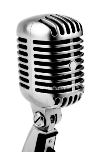 Here are some tips and techniques for treating vocal tracks with EQ while mixing.
Here are some tips and techniques for treating vocal tracks with EQ while mixing.
Most importantly: Every voice is different, and every song is different. That advice bears remembering, even if you’ve heard it dozens of times. When you find yourself approaching a vocal mix on auto-pilot, applying effects “because they worked last time,” consider disabling the EQ altogether to gauge just how badly the adjustments are needed.
Reasons to EQ: The 3 main reasons to filter a vocal with EQ are
1) to help the voice sit better in the mix,
2) to correct a specific problem, and
3) to create a deliberate effect, like “A.M. radio voice.”
If you’ve EQ’d a vocal track for some other reason, be sure the result is improving the mix.
Gentle boosts: The “cut narrow, boost wide” guideline applies to vocals perhaps more than any instrument. Our ears have evolved remarkable sensitivity to the sound of human speech. (Consider how easily we pick up a single conversation in a crowded noisy room.) So we’re immediately, instinctively aware when a voice has been processed unnaturally.
High-pass: Most vocals – though of course not all – benefit from a low cut filter. The average fundamental frequency in an adult male voice is 125Hz, and often you can roll off up to 180Hz without affecting the sound. (If your mic or preamp has a low-cut filter, consider engaging it when recording vocals, as most subsonic audio in a vocal track consists of mic-stand noise, breath rumble, popping, and other undesirable sounds.)
Bypass: Especially with high-pass filters, it’s easy to remove too much body from a vocal, as our ears adjust so quickly to new sounds when mixing. If your EQ has a bypass option, use it periodically to make sure you haven’t gone too far with an adjustment.
Common fixes:
- To reduce a nasal sound, try dipping a few dB around 1kHz, and moving the center frequency slightly up or down to find the most effective point.
- To treat popping P’s and T’s, cut everything below 80 Hz.
- For a little extra clarity and presence, try gently boosting the “vocal presence range” between 4kHz and 6kHz.
Reasons NOT to EQ: EQ can’t make your voice sound like someone else’s.
See Also: Better vocals improve your recordings, Great free vocal plugins
For more home recording tips,
Subscribe to the Hometracked feed, or receive email updates.

34 comments
Trackback URI Comments feed for this article
Great article, I really like it!!
thanks for sharing this with all of us
Best
another frequency not to overlook is the 250 hz area , I call it the muddy area
it can make vocals sit much better in the mix or too thin if not equalized correctly
Great Vocal EQ Tips forum ,It really is a great profession for those that want to work in a recording studio.
Yeah, nice tips there. I tried these tips on the vocals and it´s true, every voice is different and every song is different. I have 3 different voices in the song I´m currently working on and I had to approach each voice a little bit differently – very interesting and these tips made the whole mixing process easier than I thought. Thanks a lot :-)
Super DOPE read. I love it! Hey if you need any help or advice for your audience on recording, mixing, and mastering feel free to point them to my Youtube Video and channel where they can get free tips and tutorials on how to make there music sound just as quality as the professionals! : https://youtu.be/qLlSpLjNTm0
More Comments: ‹ Previous · 1 · 2